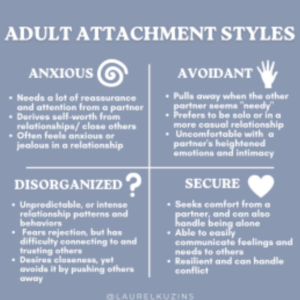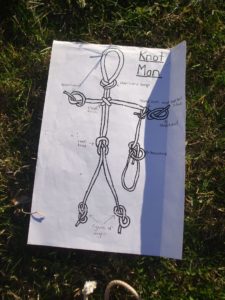
Attachment Styles
As we know, every individual person has had a unique life experience. There are people who grow up in the same environment yet their personalities and relationship dynamics can be quite different. Some may wonder why that is. One reason for this can be found in Attachment Theory. The theory of attachment was founded by John Bowlby and was furthered by Mary Ainsworth, who theorized that emotional issues within relationships can be tied back to early attachment related experiences with a child’s parents (Cassidy, Jones, Shaver, 2013). The common types of attachment are identified as Secure attachment, Anxious attachment, Avoidant attachment, and Anxious avoidant (Disorganized) attachment.
What do these different types mean? Let’s begin with Secure attachment. Secure attachment is best understood as an individual having trust in their caregivers responsiveness and availability. When it comes to romantic relationships, an individual may feel comfortable with their partner and able to communicate more easily about their emotions. Next, let’s look at anxious attachment. This attachment style is caused by the child experiencing a caregiver who is unreliable or inconsistent during childhood. This might then impact an adult who has fear of abandonment or rejection, seeking validation from their partner.
Avoidant attachment is yet another component of attachment. Avoidant attachment is caused by a child who does not consistently receive care and attention that they need from a parent. For an adult, this may come out in your relationships by recognizing that you struggle to trust others or open up to them. Lastly, anxious avoidant or disorganized attachment shows a mixed attachment style for an individual. They avoid intimacy and close relationships, yet also fear abandonment. An individual may want to be independent yet when a partner is unavailable, they begin seeking constant validation from them.
Our bonds are relationships and they are developed during times of distress (Olufowote, Fife, Schleiden, Whiting, 2019). Now that we know what the attachment styles are and briefly how they can impact relationships, now what? Many people feel stuck when it comes to this. They wonder if they’ll ever be able to “shake” these patterns of behavior. While it can be hard to challenge these patterns, the good news is that we are able to work through these reactions. Understanding our attachment styles is an important cornerstone to understanding our interactions with others and how they might change (Olufowote et al., 2019). A lot of research has been done and continues to be done on this topic. Positive attachment changes are possible, some scholars call this “earning security” throughout an individuals life (Olufowte et al., 2019).
One way a person might begin to “earn security” includes working on having more flexibility with ones cognitions (i.e. how they view themselves). Cognitive challenging helps reshape ones thought patterns and shift from a more rigid view of themselves to one that allows a person to slow down and have more grace for themselves within relationships. Another way to challenge these attachment patterns is through therapy and surrounding yourself with secure individuals that help build that security within yourself (Saunders et al, 2011). While more research should be done on this, the literature states how the these interactions can increase a persons ability to challenge and change their attachment patterns.
In the end, our attachment styles are not the end all be all of who we are as a person. It does not define our worth or our ability to love or be loved within relationships. Attachment styles help us understand where we come from. It’s what we do with the information that matters.
Works Cited
Cassidy, J., Jones, J. D., & Shaver, P. R. (2013). Contributions of attachment theory and research: a framework for future research, translation, and policy. Development and psychopathology, 25(4 Pt 2), 1415–1434. https://doi.org/10.1017/S0954579413000692
Dansby Olufowote, R. A., Fife, S. T., Schleiden, C., & Whiting, J. B. (2020). How can I become more secure?: A grounded theory of earning secure attachment. Journal of Marital and Family Therapy, 46(3), 489-506.
Saunders, R., Jacobvitz, D., Zaccagnino, M., Beverung, L. M., & Hazen, N. (2011). Pathways to earned-security: The role of alternative support figures. Attachment & Human Development, 13, 403–420. https://doi.org/10. 1080/14616734.2011.584405.
“Attachment styles help us understand where we come from. It’s what we do with the information that matters.“









